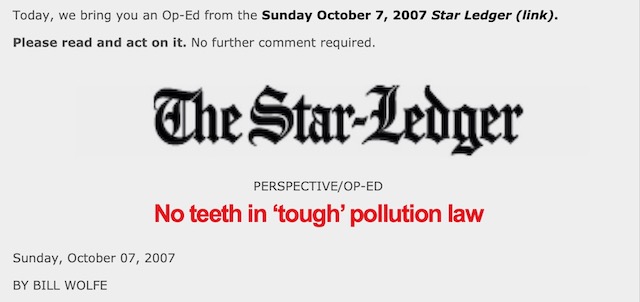NJ Legislature Considering Another Misleading Climate Bill That Sets Aspirational Goals
100% Renewable Energy By 2035 Is Another Climate Fraud
Bill Would Actually Harm NJ Solar Expansion And In State Renewable Energy Jobs
Cheered on by climate and environmental activists, the NJ Global Warming Response Act (Act) was signed into law over 16 years ago.
Over that timeframe, it has become obvious that the greenhouse gas emissions reduction goals of the Act have absolutely no teeth required to implement them and therefore those goals are purely aspirational and effectively meaningless symbolic gestures.
We predicted this at the outset, in a Sunday Star Ledger Op-Ed:
It also has become clear that climate and environmental activists were duped by legislators, the DEP Commissioner, and Gov. Corzine into their support for what amounts to a political stunt and fraud on the public. It is very easy politically to set lofty goals in the distant future that don’t require anyone to do anything to attain those goals, mandate that DEP adopt regulations, and dedicate funding to achieve those goals.
In turn, climate and environmental activists – wittingly or unwittingly – have been misleading the public in their false praise of the law.
 But apparently, the same legislators and those same climate and environmental groups have not yet learned those lessons of the failed Global Warming Response Act.
But apparently, the same legislators and those same climate and environmental groups have not yet learned those lessons of the failed Global Warming Response Act.
They are repeating the exact same mistakes that delivered the toothless Global Warming Response Act – this time by supporting aspirational renewable energy goals that rely on market incentives.
The renewable energy bill considered today (S2978 SCS) would revise NJ’s current renewable energy portfolio standards to create “clean electricity attribute certificates (CEACs)” and direct the BPU to:
require electricity suppliers to purchase CEACs equivalent to 80 percent of their retails sales by 2027, 85 percent by 2030, and 100 percent by 2035.
Sounds good, right?
But even if the bill were to achieve its goals – and 100% of retail sales of electricity were “renewable” – there is no guarantee that current NJ based greenhouse gas emissions would be reduced by one ton or that even out of state emissions be reduced.
The bill does not mandate that current NJ emissions be reduced or that current fossil power sources are phased out. There are no limits on expansion of current NJ fossil power and fossil infrastructure to meet electric demand, both in NJ and the wider PJM region. Those power plants will continue to operate and continue to emit greenhouse gases.
And as I’ve written before, given the projected more than doubling of NJ electric demand as a result of electrification of transportation and buildings, the current fossil generating sources will continue to operate and continue to emit greenhouse gases. At a regional level, there will continue to be demand for that fossil power.
For an explanation and solid analysis of how renewables serve new demand growth and will not reduce greenhouse gas emissions, see:
The power currently produced by NJ gas fossil plants, served by fossil pipelines, will continue to be sold into the regional PJM grid and be exported to other States.
There are several fatal flaws in the bill.
First, the bill effectively would put the regional grid operator – a private corporate entity known as PJM – in charge of the grid, access to the grid from renewable power sources, define “zero carbon”, “environmental benefits or attributes” and “net” issues, and delegate power to PJM to block expansion of renewables based on “reliability” concerns (that is done in Section 9):
“Clean electricity attribute certificate” or “CEAC” means a certificate representing the zero-carbon or environmental benefits or attributes of one megawatt-hour of generation from a clean electricity production facility whose electricity is produced in New Jersey or settled through the wholesale energy markets operated by PJM Interconnection, L.L.C., or any successor organization, or such other quantity of generation, as may be adjusted by the board pursuant to subsection a. of section 5 of P.L. , c. (C. ) (pending before the Legislature as this bill), to account for the greenhouse gas abatement achieved by the clean electricity production facility.
Second, the bill allows for renewable energy imports from other states (for which NJ has no power to control and enforce actual renewable energy: (according to the bill’s Statement:
The BPU would be authorized to require an electricity supplier to meet a portion, or all, of its clean electricity procurement obligations established by the bill through participation in a regional clean electricity attribute market established or approved by the BPU, a regional transmission organization (e.g., PJM Interconnection, L.L.C., New Jersey’s current regional transmission organization), or another qualified entity.
For an example of the likely abuses associate with “renewable energy imports”, consider the case of Maryland and the Physicians For Social Respsonsibility Report: (PEER Report)
A large and growing portion of Maryland’s renewable “clean energy” comes from high-polluting energy sources. In 2019 alone, approximately 40% of the energy attributed to the state’s Tier 1 Renewable Portfolio Standard (RPS) came from “dirty” sources, up by more than a fifth from just the year prior.
Importation of renewable power also would undermine the growth of in state renewable power and expansion of jobs in renewable energy sector.
Importation of renewable power will export NJ consumer funds to out of state businesses, the exact opposite of investing in New Jersey.
If the bill actually mandated reduction of instate greenhouse gas emissions and/or phased out existing fossil power, then the imports of renewable energy might be justified. But with no such guarantees, the bill results in the worst of all worlds: it would undermine NJ’s renewable energy sector and do nothing to reduce current NJ greenhouse gas emissions.
Finally, there appears to be some confusion about the impact of the bill on NJ’s currently polluting garbage incinerators, all of which are located in environmental justice communities. I sense that this confusion may be a political game to cultivate the support of the bill by EJ and climate activists with a false promise.
NJ Spotlight falsely reported that the bill would “phase out” those incinerators:
Another battle may be brewing over whether the bill includes a provision phasing out garbage incinerators, a priority for environmental justice advocates.
“Incineration is dirty energy and should not be considered clean,’’ said Maria Lopez- Nuñez, deputy director of the Ironbound Community Corporation.
“We’re in a climate crisis,’’ added Doug O’Malley, director of Environment New Jersey. “We need legislation that incentivizes in-state renewables and prevents fossil fuel generation and co-pollutants [such as arsenic, mercury and other contaminants].”
The bill would not “phase out” those incinerators. It would merely not allow them to be considered a “clean energy production facility” and eligible for participation in the program:
“Clean electricity production facility” shall not include a resource recovery facility.
Just like the current fossil gas power plants, they too would continue to pollute.
And the bill does not “incentivizes in-state renewables” – just the opposite: (NJ Spotlight)
... solar developers fear the bill will lead to New Jersey relying on less costly out-of-state solar systems instead of in-state systems.
“This is providing room for zero solar growth in New Jersey from here on in,’’ said Lyle Rawlings, founder and president of Advanced Solar Products in Flemington.
The bill has language suggesting most of the new solar capacity will come from outside New Jersey where land and labor costs are cheaper.
Doug O’Malley is being duped again. Fool me once….
[End Note: And for chairman Smith to move this bill in the lame duck session is pure political cowardice and highly inappropriate abuse of process.]
